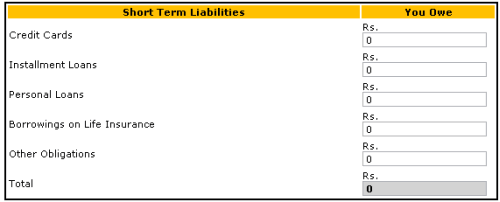 | « Back to article | Print this article |
A do-it-yourself guide to calculate your net worth
Your net worth is simply the value of what you own (total assets) less what you owe (total liabilities).
The first step in calculating your net worth is to estimate the value of your total assets. The tables given below and the values highlighted in each of the tables to follow are for illustrative purposes. You can calculate your net worth by entering your respective assets and liabilities.

Liquid assets
Your liquidity is your financial ability to respond swiftly to emergencies or investment opportunities. Liquidity consists of your cash accounts and short-term investments such as fixed deposits, savings account, company deposits, KVP (Kisan Vikas Patra), NSC (National Savings Certificate), Post Office deposits etc. Your need for liquidity is influenced by the predictability of your cash income and expenses, by your employment security, and by your investment strategy.

It is generally held that your liquid assets should roughly equal employment income of four to six months. If you are in an unstable employment situation or about to make a large investment, the amount should probably be greater. If your employment is relatively secure and you anticipate no major cash expenditures in the near future, the amount should be smaller.
Investment assets
Investment assets are defined as long-term investments, and are intended to store value for major future needs like education expenses and retirement. Stocks, bonds, insurance policies, mutual funds and real estate (other than personal residence and vacation property) are typical investment assets.
So are investments in alternative assets, such as hedge funds and commodity funds. Retirement funds, too, are classified as investment assets. These may include Provident Fund, PPF, Pension Plans etc.

Personal assets
Items you acquire for your own or your family's long-term use or enjoyment form part of your personal assets. Typically, they include your private residence and vacation home as well as any cars, art, antiques, and furnishings that you own.
Congratulations! You have now calculated your total assets. This is the combined sum of your total liquid assets, total investment assets, and total personal assets.

Short-term liabilities
Your net worth is simply the value of what you own (total assets) less what you owe (total liabilities).

The first step in calculating your net worth was to estimate the value of your total assets -- which you should have done here. Next you have to estimate the value of your liabilities - which are of two types: short-term liabilities and long-term liabilities. For most people, both are fairly easy to calculate, and you can do this in the forms below.
Short-term liabilities
Short-term liabilities are defined as all debts that have to be paid within the next 12 months. Typically, these might include credit card payments, short-term installment loans, personal loans, accrued income taxes, or borrowings on life insurance. Short-term liabilities also include whatever amounts of interest are due on long-term debts within the next 12 months.

Long-term liabilities
Most long-term liabilities are incurred for the following purposes: to finance long-term investments like real estate, investments, or major personal assets like your residence or vacation property. Normally, the asset purchased constitutes security for the lender in case you default on your loan.
Over time, the value of the investment asset you purchased with borrowed funds may increase, while the amount of your obligation usually decreases. Thus, your equity - the difference between the current value of the asset and the current balance of the loan - usually increases.
Note: It is important to remember that there are circumstances where the value of an investment does not appreciate. For instance, depending on the price that you paid for your home or other investment asset, a downturn in the economy may find you owing more on the liability than the asset is worth. Therefore, the decision to borrow funds should be considered carefully, and based on your ability to finance both the interest and principal payments due on the loan over time.

You should now have an estimate of your net worth. However if having estimated your liabilities, you wish to re-adjust your asset calculation, you can always return to the first part of this how-to guide that calculates your toral assets.

